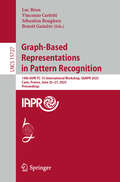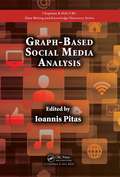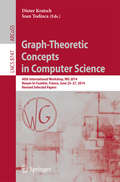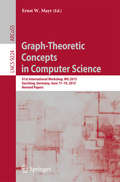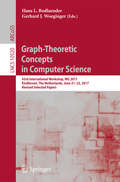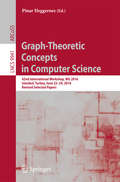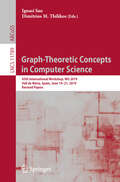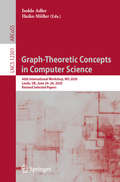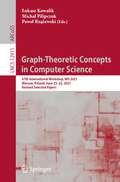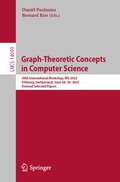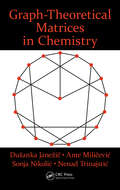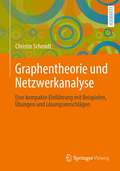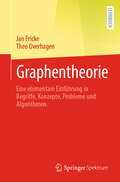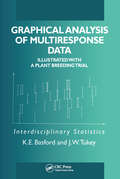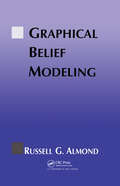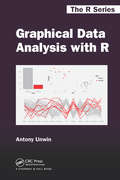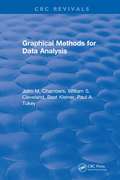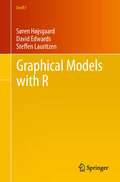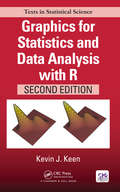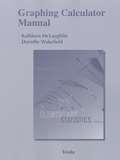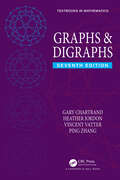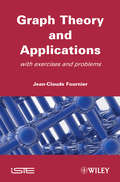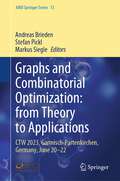- Table View
- List View
Graph-Based Representations in Pattern Recognition: 14th IAPR-TC-15 International Workshop, GbRPR 2025, Caen, France, June 25–27, 2025, Proceedings (Lecture Notes in Computer Science #15727)
by Luc Brun Vincenzo Carletti Sébastien Bougleux Benoît GaüzèreThis book constitutes the refereed proceedings of the 14th IAPR-TC-15 International Workshop on Graph-Based Representations in Pattern Recognition, GbRPR 2025, held in Caen, France, in June 2025. The 25 full papers presented here were carefully reviewed and selected from 33 submissions. They are organized as per the following topical sections: Cybersecurity based on Graph models; Graph based bioinformatics; Graph similarities and graph patterns; GNN: shortcomings and solutions; Graph learning and computer vision.
Graph-Based Social Media Analysis (Chapman & Hall/CRC Data Mining and Knowledge Discovery Series)
by Ioannis PitasFocused on the mathematical foundations of social media analysis, Graph-Based Social Media Analysis provides a comprehensive introduction to the use of graph analysis in the study of social and digital media. It addresses an important scientific and technological challenge, namely the confluence of graph analysis and network theory with linear alge
Graph-Theoretic Concepts in Computer Science
by Dieter Kratsch Ioan TodincaThis book constitutes the thoroughly refereed post-conference proceedings of the 40th International Workshop on Graph-Theoretic Concepts in Computer Science, WG 2014, held in Nouan-le-Fuzelier, France, in June 2014. The 32 revised full papers presented were carefully reviewed and selected from 80 submissions. The book also includes two invited papers. The papers cover a wide range of topics in graph theory related to computer science, such as design and analysis of sequential, parallel, randomized, parameterized and distributed graph and network algorithms; structural graph theory with algorithmic or complexity applications; computational complexity of graph and network problems; graph grammars, graph rewriting systems and graph modeling; graph drawing and layouts; computational geometry; random graphs and models of the web and scale-free networks; and support of these concepts by suitable implementations and applications.
Graph-Theoretic Concepts in Computer Science
by Ernst W. MayrThis volume presents the proceedings of the 20th International Workshop on Graph-Theoretic Concepts in Computer Science (WG '94), held in Herrsching, Germany in June 1994. The volume contains 32 thoroughly revised papers selected from 66 submissions and provides an up-to-date snapshot of the research performed in the field. The topics addressed are graph grammars, treewidth, special graph classes, algorithms on graphs, broadcasting and architecture, planar graphs and related problems, and special graph problems.
Graph-Theoretic Concepts in Computer Science
by Gerhard J. Woeginger Hans L. BodlaenderThe 29th International Workshop on Graph-Theoretic Concepts in Computer Science(WG2003)washeldintheMennorodeconferenceCenterinElspeet,The Netherlands. TheworkshopwasorganizedbytheCenterforAlgorithmicSystems of the Institute of Information and Computing Sciences of Utrecht University. The workshop took place June 19-21, 2003. The 72 participants of WG 2003 came from universities and research institutes from 18 di?erent countries and ?ve di?erent continents. The workshop looks back at a long tradition. It was ?rst held in 1975, and has been held 20 times in Germany, twice in Austria, and once in Italy, Slo- kia, Switzerland, and the Czech Republic, and has now been held for the third time in The Netherlands. The workshop aims at uniting theory and practice by demonstrating how graph-theoretic concepts can be applied to various areas in computerscience,orbyextractingnewproblemsfromapplications. Itisdevoted to the theoretical and practical aspects of graph concepts in computer science. The goal is to present recent research results and to identify and explore - rections of future research. The talks given at the workshop showed how recent research results from algorithmic graph theory can be used in computer science and which graph-theoretic questions arise from new developments in computer science.
Graph-Theoretic Concepts in Computer Science
by Pinar HeggernesThis book constitutes revised selected papers from the 42nd International Workshop on Graph-Theoretic Concepts in Computer Science, WG 2016, held in Istanbul, Turkey, in June 2016. The 25 papers presented in this volume were carefully reviewed and selected from 74 submissions. The WG conferences aim to connect theory and practice by demonstrating how graph-theoretic concepts can be applied to various areas of computer science and by extracting new graph problems from applications. Their goal is to present new research results and to identify and explore directions of future research.
Graph-Theoretic Concepts in Computer Science: 45th International Workshop, WG 2019, Vall de Núria, Spain, June 19–21, 2019, Revised Papers (Lecture Notes in Computer Science #11789)
by Ignasi Sau Dimitrios M. ThilikosThis book constitutes the revised papers of the 45th International Workshop on Graph-Theoretic Concepts in Computer Science, WG 2019, held in Vall de Núria, Spain, in June 2019. The 29 full papers presented in this volume were carefully reviewed and selected from 87 submissions. They cover a wide range of areas, aiming at connecting theory and applications by demonstrating how graph-theoretic concepts can be applied in various areas of computer science. Another focus is on presenting recent results and on identifying and exploring promising directions of future research.
Graph-Theoretic Concepts in Computer Science: 46th International Workshop, WG 2020, Leeds, UK, June 24–26, 2020, Revised Selected Papers (Lecture Notes in Computer Science #12301)
by Isolde Adler Haiko MüllerThis book constitutes the revised papers of the 46th International Workshop on Graph-Theoretic Concepts in Computer Science, WG 2020, held in Leeds, UK, in June 2020. The workshop was held virtually due to the COVID-19 pandemic. The 32 full papers presented in this volume were carefully reviewed and selected from 94 submissions. They cover a wide range of areas, aiming to present emerging research results and to identify and explore directions of future research of concepts on graph theory and how they can be applied to various areas in computer science.
Graph-Theoretic Concepts in Computer Science: 47th International Workshop, WG 2021, Warsaw, Poland, June 23–25, 2021, Revised Selected Papers (Lecture Notes in Computer Science #12911)
by Łukasz Kowalik Michał Pilipczuk Paweł RzążewskiThis book constitutes the proceedings of the 47th International Workshop on Graph-Theoretic Concepts in Computer Science which was held during June 23–25, 2021. The conference was planned to take place in Warsaw, Poland, but changed to an online event due to the COVID-19 pandemic. The 30 full papers included in this volume were carefully reviewed and selected from 73 submissions. The conference aims to merge theory and practice by demonstrating how concepts from graph theory can be applied to various areas in computer science or by extracting new graph-theoretic problems from applications.Chapter “Bears with Hats and Independence Polynomials” is are available open access under a Creative Commons Attribution 4.0 International License via link.springer.com.
Graph-Theoretic Concepts in Computer Science: 49th International Workshop, WG 2023, Fribourg, Switzerland, June 28–30, 2023, Revised Selected Papers (Lecture Notes in Computer Science #14093)
by Daniël Paulusma Bernard RiesThis volume constitutes the thoroughly refereed proceedings of the 49th International Workshop on Graph-Theoretic Concepts in Computer Science, WG 2023. The 33 full papers presented in this volume were carefully reviewed and selected from a total of 116 submissions. The WG 2022 workshop aims to merge theory and practice by demonstrating how concepts from graph theory can be applied to various areas in computer science, or by extracting new graph theoretic problems from applications.
Graph-Theoretic Concepts in Computer Science: 50th International Workshop, WG 2024, Gozd Martuljek, Slovenia, June 19–21, 2024, Revised Selected Papers (Lecture Notes in Computer Science #14760)
by Daniel Kráľ Martin MilaničThis book constitutes the refereed proceedings of the 50th International Workshop on Graph-Theoretic Concepts in Computer Science, WG 2024, held in Gozd Martuljek, Slovenia in June 2024, The 31 papers presented in this volume were carefully reviewed and selected from 89 submissions. Additionally, this volume also contains a survey on approximation algorithms for tree-width, path-width, and tree-depth prepared by Hans Bodlander, who delivered the Test of Time Award talk at WG 2024. The WG 2024 workshop aims to merge theory and practice by demonstrating how concepts from graph theory can be applied to various areas in computer science or by extracting new graph-theoretic problems from applications.
Graph-Theoretical Matrices in Chemistry
by Dusanka Janezic Ante Milicevic Sonja Nikolic Nenad TrinajsticGraph-Theoretical Matrices in Chemistry presents a systematic survey of graph-theoretical matrices and highlights their potential uses. This comprehensive volume is an updated, extended version of a former bestseller featuring a series of mathematical chemistry monographs. In this edition, nearly 200 graph-theoretical matrices are included.This sec
Graphentheorie und Netzwerkanalyse: Eine kompakte Einführung mit Beispielen, Übungen und Lösungsvorschlägen
by Christin SchmidtDieses Lehrbuch bietet eine kompakte Einführung in die Grundlagen der Graphentheorie und die Methoden der Netzwerkanalyse. Zahlreiche praktische Beispiele und Übungsaufgaben mit Lösungsvorschlägen helfen Leser:innen dabei, die theoretischen Konzepte besser zu verstehen und anzuwenden. Dabei werden unterschiedliche Technologien und Programmiersprachen verwendet, um ein breites Spektrum an Anwendungen abzudecken. Darüber hinaus beleuchten spezielle Kapitel die Methodik mit Blick auf die Planung und Durchführung eigener Netzwerkanalyseprojekte sowie ethische und datenschutzrechtliche Aspekte. So liefert das Buch nicht nur einen theoretischen Überblick, sondern auch praktische Tipps und Anleitungen für die Untersuchung eigener netzwerkanalytischer Fragestellungen. Dieses Buch eignet sich nicht nur als Nachschlagewerk für Studierende und Dozierende vielfältiger Fachdisziplinen mit curricularem Bezug zum Thema, sondern auch als Ergänzung des Repertoires von Praktiker:innen im Bereich Data Science mit Interesse an der Untersuchung von Netzwerken. Ob als theoretischer Einstieg oder als praktischer Ratgeber - dieses Buch leistet einen Beitrag für die Untersuchung und Analyse von Netzwerken und bietet eine Grundlage für weiterführende Studien und Projekte.
Graphentheorie: Eine elementare Einführung in Begriffe, Konzepte, Probleme und Algorithmen
by Jan Fricke Theo OverhagenDieses kompakte Lehrbuch führt in die grundlegenden Problemstellungen, Begriffe und Konzepte der Graphentheorie ein und liefert einen entsprechenden Überblick: In den ersten beiden Kapiteln werden die grundlegenden Begriffe geklärt – alle anderen Kapitel behandeln darauf aufbauend und weitgehend unabhängig voneinander jeweils einen wichtigen Problemkreis. Die Resultate und Lösungsalgorithmen werden dabei jeweils durch viele Beispiele, Grafiken und Übungsaufgaben veranschaulicht. Das Buch legt außerdem großen Wert auf die Erläuterung der Zusammenhänge; bis auf wenige Ausnahmen werden alle Resultate bewiesen. Zum Verständnis des Inhalts sind nur mathematische Grundkenntnisse nötig. Das Buch ist daher für Anfängervorlesungen in den ersten Semestern des Mathematikstudiums und insbesondere für Lehramtsstudierende gut geeignet. Es kann aber beispielsweise auch für Seminare, AGs oder Schülerprojekte verwendet werden.
Graphical Analysis of Multi-Response Data
by Kaye Enid Basford John Wilder TukeyA comprehensive summary of new and existing approaches to analyzing multiresponse data, Graphical Analysis of Multiresponse Data emphasizes graphical procedures. These procedures are then used, in various ways, to analyze, summarize, and present data from a specific, well-known plant breeding trial.These procedures result in overlap plots, their corresponding semigraphical tables, scatter plot matrices, profiles across environments and attributes for individual genotypes and groups of genotypes, and principal components.The interpretation of these displays, as an aid to understanding, is illustrated and discussed. Techniques for choosing expressions for the observed quantities are also emphasized.Graphical Analysis of Multiresponse Data is arranged into three parts:What can usefully be doneConsequences for the exampleApproaches and choices in more detailThat structure enables the reader to obtain an overview of what can be found, and to then delve into various aspects more deeply if desired. Statisticians, data analysts, biometricians, plant breeders, behavioral scientists, social scientists, and engineering scientists will find Graphical Analysis of Multiresponse Data offers invaluable assistance. Its details are also of interest to scientists in private firms, government institutions, and research organizations who are concerned with the analysis and interpretation of experimental multiresponse data.
Graphical Belief Modeling
by Russel .G AlmondThis innovative volume explores graphical models using belief functions as a representation of uncertainty, offering an alternative approach to problems where probability proves inadequate. Graphical Belief Modeling makes it easy to compare the two approaches while evaluating their relative strengths and limitations. The author examines both theory and computation, incorporating practical notes from the author's own experience with the BELIEF software package. As one of the first volumes to apply the Dempster-Shafer belief functions to a practical model, a substantial portion of the book is devoted to a single example--calculating the reliability of a complex system. This special feature enables readers to gain a thorough understanding of the application of this methodology.The first section provides a description of graphical belief models and probablistic graphical models that form an important subset: the second section discusses the algorithm used in the manipulation of graphical models: the final segment of the book offers a complete description of the risk assessment example, as well as the methodology used to describe it. Graphical Belief Modeling offers researchers and graduate students in artificial intelligence and statistics more than just a new approach to an old reliability task: it provides them with an invaluable illustration of the process of graphical belief modeling.
Graphical Data Analysis with R (Chapman & Hall/CRC The R Series #27)
by Antony UnwinSee How Graphics Reveal Information Graphical Data Analysis with R shows you what information you can gain from graphical displays. The book focuses on why you draw graphics to display data and which graphics to draw (and uses R to do so). All the datasets are available in R or one of its packages and the R code is available at rosuda.org/GDA. Graphical data analysis is useful for data cleaning, exploring data structure, detecting outliers and unusual groups, identifying trends and clusters, spotting local patterns, evaluating modelling output, and presenting results. This book guides you in choosing graphics and understanding what information you can glean from them. It can be used as a primary text in a graphical data analysis course or as a supplement in a statistics course. Colour graphics are used throughout.
Graphical Methods for Data Analysis
by J. M. ChambersThis book present graphical methods for analysing data. Some methods are new and some are old, some require a computer and others only paper and pencil; but they are all powerful data analysis tools. In many situations, a set of data � even a large set- can be adequately analysed through graphical methods alone. In most other situations, a few well-chosen graphical displays can significantly enhance numerical statistical analyses.
Graphical Models with R
by David Edwards Søren Højsgaard Steffen LauritzenGraphical models in their modern form have been around since the late 1970s and appear today in many areas of the sciences. Along with the ongoing developments of graphical models, a number of different graphical modeling software programs have been written over the years. In recent years many of these software developments have taken place within the R community, either in the form of new packages or by providing an R interface to existing software. This book attempts to give the reader a gentle introduction to graphical modeling using R and the main features of some of these packages. In addition, the book provides examples of how more advanced aspects of graphical modeling can be represented and handled within R. Topics covered in the seven chapters include graphical models for contingency tables, Gaussian and mixed graphical models, Bayesian networks and modeling high dimensional data.
Graphics for Statistics and Data Analysis with R (Chapman & Hall/CRC Texts in Statistical Science)
by Kevin J. Keen<p>Graphics for Statistics and Data Analysis with R, Second Edition, presents the basic principles of graphical design and applies these principles to engaging examples using the graphics and lattice packages in R. It offers a wide array of modern graphical displays for data visualization and representation. Added in the second edition are coverage of the ggplot2 graphics package, material on human visualization and color rendering in R, on screen, and in print. It emphasizes the fundamentals of statistical graphics and best practice guidelines for producing and choosing among graphical displays in R. <p>Provides downloadable R code and data for figures at www.graphicsforstatistics.com</p>
Graphics for Statistics and Data Analysis with R (Chapman & Hall/CRC Texts in Statistical Science)
by Kevin J. Keen<i>Graphics for Statistics and Data Analysis with R, Second Edition</i>, presents the basic principles of graphical design and applies these principles to engaging examples using the graphics and lattice packages in R. It offers a wide array of modern graphical displays for data visualization and representation. Added in the second edition are coverage of the ggplot2 graphics package, material on human visualization and color rendering in R, on screen, and in print.
Graphing Calculator Manual
by Mario F. Triola Kathleen Mclaughlin Dorothy WakefieldThis manual is organized to follow the sequence of topics in the textbook, and it is an easy-to-follow, step-by-step guide on how to use the TI-83/84 Plus graphing calculator. It provides worked-out examples to help students fully understand and use the graphing calculator.
Graphs & Digraphs (Textbooks in Mathematics)
by Ping Zhang Gary Chartrand Heather Jordon Vincent VatterGraphs & Digraphs, Seventh Edition masterfully employs student-friendly exposition, clear proofs, abundant examples, and numerous exercises to provide an essential understanding of the concepts, theorems, history, and applications of graph theory. This classic text, widely popular among students and instructors alike for decades, is thoroughly streamlined in this new, seventh edition, to present a text consistent with contemporary expectations. Changes and updates to this edition include: • A rewrite of four chapters from the ground up. • Streamlining by over a third for efficient, comprehensive coverage of graph theory. • Flexible structure with foundational Chapters 1–6 and customizable topics in Chapters 7–11. • Incorporation of the latest developments in fundamental graph theory. • Statements of recent groundbreaking discoveries, even if proofs are beyond scope. • Completely reorganized chapters on traversability, connectivity, coloring, and extremal graph theory to reflect recent developments. The text remains the consummate choice for an advanced undergraduate level or introductory graduate-level course exploring the subject’s fascinating history, while covering a host of interesting problems and diverse applications. Our major objective is to introduce and treat graph theory as the beautiful area of mathematics we have always found it to be. We have striven to produce a reader-friendly, carefully written book that emphasizes the mathematical theory of graphs, in all their forms. While a certain amount of mathematical maturity, including a solid understanding of proof, is required to appreciate the material, with a small number of exceptions this is the only pre-requisite. In addition, owing to the exhilarating pace of progress in the field, there have been countless developments in fundamental graph theory ever since the previous edition, and many of these discoveries have been incorporated into the book. Of course, some of the proofs of these results are beyond the scope of the book, in which cases we have only included their statements. In other cases, however, these new results have led us to completely reorganize our presentation. Two examples are the chapters on coloring and extremal graph theory.
Graphs Theory and Applications: With Exercises and Problems (Wiley-iste Ser.)
by Jean-Claude FournierThis book provides a pedagogical and comprehensive introduction to graph theory and its applications. It contains all the standard basic material and develops significant topics and applications, such as: colorings and the timetabling problem, matchings and the optimal assignment problem, and Hamiltonian cycles and the traveling salesman problem, to name but a few. Exercises at various levels are given at the end of each chapter, and a final chapter presents a few general problems with hints for solutions, thus providing the reader with the opportunity to test and refine their knowledge on the subject. An appendix outlines the basis of computational complexity theory, in particular the definition of NP-completeness, which is essential for algorithmic applications.
Graphs and Combinatorial Optimization: CTW 2023, Garmisch-Partenkirchen, Germany, June 20–22 (AIRO Springer Series #13)
by Stefan Pickl Andreas Brieden Markus SiegleThis book contains the proceedings of the 19th Cologne-Twente Workshop on Graphs and Combinatorial Optimization, held during June 20-22, 2023, in Garmisch-Partenkirchen, Germany. This successful series of international workshops is known to attract high-quality research on the theory and application of discrete algorithms, graphs, and combinatorial optimization in a wide sense. The papers collected in this book represent cutting-edge research by leading researchers and attract a broad readership in academia worldwide. The book is addressed to researchers and advanced students, but also to professionals in industry concerned with algorithm design and optimization problems in different areas of application.
